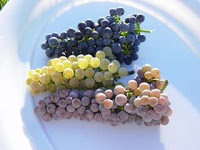I am always on the lookout for unusual grapes and I  spotted two Cabernets that are decidedly different recently. Cleggett Wines in Langhorne Creek, South Australia have two new grape varietals that are a Bronze and a White Cabernet Sauvignon.
spotted two Cabernets that are decidedly different recently. Cleggett Wines in Langhorne Creek, South Australia have two new grape varietals that are a Bronze and a White Cabernet Sauvignon.
A chance discovery of pinky bronze fruit on a Cabernet Sauvignon vine in 1977 provided Mac Cleggett and Anne McLennan the opportunity to propagate this single (cane) cutting.
This Bronze Cabernet Sauvi gnon grape is registered as Malian.
gnon grape is registered as Malian.
Several years later in 1991 a white sport was discovered and subsequently registered as Shalistin.
Following many years of development and additional plantings, two new grape varietals, both with the same DNA make up as the parent Cabernet vine, are now producing excellent fruit.
Cleggett Wines make both a sweet and a dry white wine from Shalistin, a red and a sparkling red from Malian and a Rosé from the Malian and Cabernet Franc.
Compared to its Cabernet parent , Malian appears to lack anthocyanins (pigments) in the subepidermal cells but retains them in the epidermis, whereas Shalistin has no anthocyanins in either layer – making it an “Albino”.
, Malian appears to lack anthocyanins (pigments) in the subepidermal cells but retains them in the epidermis, whereas Shalistin has no anthocyanins in either layer – making it an “Albino”.
The team that went on to discover the VvMYBA1 and VvMYBA2 genes that control grape colour have suggested that a gene involved in anthocyanin production has been deleted in the subepidermis of Malian, and then subepidermal cells invaded the epidermis to produce Shalistin.
In France a similar situation arose with the Pinot Noir grape in Burgundy. In 1936, in the Nuits-St-Georges vineyards of Henri Gouges it was found that some of the old Pinot Noir vines were producing white grapes. Cuttings were taken and the white vines were planted in Les Perrières and 3 white wines are produced:
Clos des Porrets St-George 1er Cru, La Perrière 1er Cru and Bourgogne “Pinot Blanc.” These w hite grapes are known as Pinot Gouges or sometimes Pinot Musigny.
hite grapes are known as Pinot Gouges or sometimes Pinot Musigny.
It’s not only Pinot Noir that is prone to mutating – there is a Merlot Blanc that is apparently a mutant of the black Merlot grape and originates in the Languedoc region of France.
The popularity of White Merlot wines around at the moment makes it very confusing as these are actually made from the black Merlot grape in a Rosé style. I have not been able to find out much information at all on the White Merlot grape – does anyone out there have any?
Moving on to Spain there is a White Tempranilllo – in 1988, Jesús Galilea Esteban found a cluster of white grapes on one of the Tempranillo vines in his vineyard, Murillo de Rio Leza, loc ated in Rioja.
ated in Rioja.
He removed the cluster, leaving a heel which in turn produced two buds of white grapes. Galilea then contacted the Rioja government agency CIDA, who grafted the buds at their research station in February 1989.
Once the mutation had stabilized, the CIDA expanded their collection to 100 vines in 1993, and started to make wine on an experimental scale. The first bottling of wine was in 2005, from a hectare of vines planted in 2000.
White Tempranillo is currently being distributed to growers having been registered with the State and approved for use in the Rioja D.O.Ca.
 Back in 2007 it was discovered that originally grape vines only bore red grapes until 3000 years ago (see White Grapes are Mutants). I wonder what triggered the change? The Scientists think it would have most likely occurred before the time of Tutankhamen.
Back in 2007 it was discovered that originally grape vines only bore red grapes until 3000 years ago (see White Grapes are Mutants). I wonder what triggered the change? The Scientists think it would have most likely occurred before the time of Tutankhamen.
White wine residue was found in flasks within the ancient Egyptian king’s tomb. Maybe some erstwhile Egyptian ambling through his vineyard saw these strange new white grapes and wondered whether they’d make good wine!

